Bulbs in the garden: lilies, planting and care
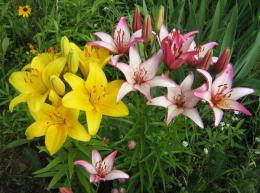
The bright and at the same time graceful flowering of lilies attracts the eyes of even people who are indifferent to flowers. The variety of shapes and colors of inflorescences, from innocent snow-white to dark burgundy, satisfies the most demanding and picky gardener.
Content:
- Lilies, general information
- Choosing a place and soil for growing lilies
- Planting lilies
- Caring for lilies
Lilies, general information
Growing lilies, planting and caring for them can be done by both a professional and an amateur. It is important to follow just a few rules:
- choosing the right variety
- choice planting material
- choice of location
- landing
- care
- disease control
To do this correctly, it is important to understand some of the biological characteristics of lilies.
Lilies - these plants are perennial herbaceous bulbous plants. Lily bulbs are formed by nothing more than fleshy, thickened leaves called basal leaves.
The bulbs are most often painted white or yellow. Lily bulbs are edible. The bottom of the bulb turns into a straight, most often without branching, stem. Some varieties may have a few branches in the upper part. The leaves can be either petiolate or sessile on the stem.
Lily flowers are funnel-shaped or bell-shaped, formed by six elongated petals. The tops of the petals are bent, some lilies have more, almost curling, like a saranka lily, others have less.
It is noteworthy that the lilies' antlers are attached to long thin threads and secrete a sweet juice, which is attractive to pollinating insects. The plant produces a fruit capsule that contains many seeds.
In the wild, most species of these bulbous plants widespread in both Europe and Asia. About six species are found in North America. Wild species of lilies gave rise to cultivated varieties and hybrids; now there are more than thirty varieties.
Many cultivated species received unpretentiousness from their ancestors, so growing lilies in the garden is not particularly difficult.
Choosing a place and soil for growing lilies
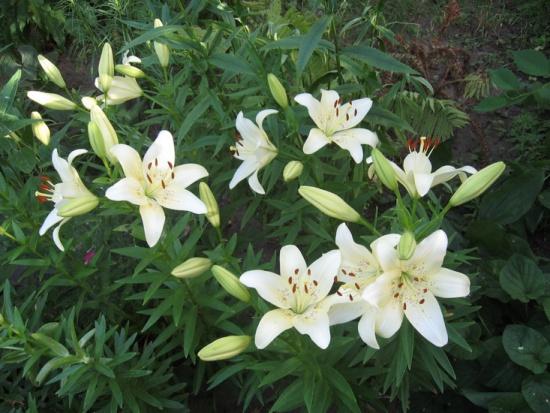
Before choosing a place in the garden for lilies, you need to decide on the types and varieties. The requirements for illumination of the site may differ, so Tubular hybrids will prefer to grow in a well-lit sunny place, while locusts and Oriental hybrids develop well in the shade. Asian hybrids are less demanding on the amount of light; they can grow in both sun and partial shade.
The soil requirements of lilies are also different. Some lilies, such as saranka and royal lilies, tolerate slightly alkaline soils with a low lime content. Long-flowered Canadian lilies cannot tolerate such soils at all.
What all lilies have in common is that they love soil with a high humus content, but are completely unsuited to growing on sandy or heavy clay soils.
If it is not possible to plant lilies on medium, sandy or loamy lands, then it is necessary to improve the soil that is present in the place chosen for the flowers. If there is sand on the site, then a clay bed should be placed under the bed.If the soil is clayey, then you need to sand it, add about 1/5 of the sand to the ground before planting the lilies. This will make the earth lighter, more air- and water-permeable.
The addition of peat, humus, and compost will also be beneficial for the growth of lilies. But under no circumstances should fresh manure be introduced. Even the best soil requires some preparation before planting the bulbs.
Planting lilies
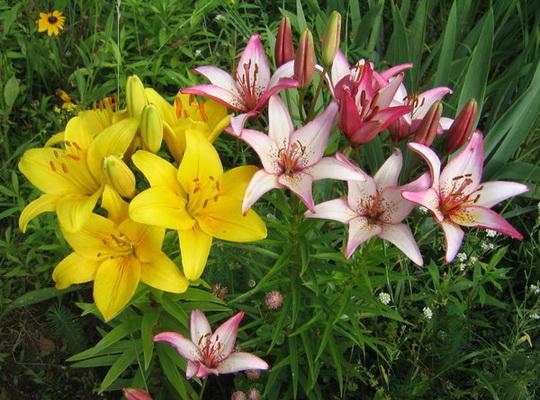
- Preparing the beds. It is advisable to dig up the bed for lilies in advance, to a depth of a bayonet or one and a half bayonets of a shovel. When digging, add mineral fertilizers containing phosphorus and potassium. If you plan to plant varieties that cannot tolerate acidic soils, then you cannot do without adding lime, chalk, and ash. At least 200 - 300 grams must be applied per square meter, and on highly acidic soils - up to 0.5 kg. If the soils are alkaline, and you plan to plant Oriental hybrids, then after adding peat, humus, and leaf soil, the soil must be shed with a strong solution of potassium permanganate. If the soil is dry, then before planting lilies it must be well moistened.
- Planting with bulbs. The most convenient way to plant lilies is with bulbs. The best planting material is large dormant bulbs with intact scales. If the bulbs look dried out, they should be immersed in the epin solution for a couple of hours. For large bulbs, the depth of the hole should be at least 20 - 25 cm, for smaller ones from 10 cm to 15 cm. After the bulb is installed in the hole, the roots should be straightened, then cover everything with soil and water generously.
- Scaling - planting with scales. This method can be used without digging the bulb out of the ground. In the fall, several outer scales are separated, washed and disinfected with fungicides.Then they are placed in damp perlite and kept at room temperature. After about 60 days, bulbs appear at the base of the scales. They should be stored until spring in a cool place. The bulb continues to feed on its scales. In spring everything is planted in the ground. This method makes sense to use when you need to propagate a very rare variety, since such a bulb will not bloom before five years.
The optimal time for planting lilies begins in the second half of August and continues until mid-September. Practice shows that bulbs are planted at a later date, and they are also planted in the spring, immediately after the soil has thawed. When planting in autumn, it is better to mulch the bed with a layer of leaf humus or peat, at least 10 cm thick.
In the first year after planting, lilies may not display the stated varietal sizes of stems and flowers. In one place, with proper care, flowers can grow for many years.
Caring for lilies
If the place for growing lilies is chosen correctly, then caring for them is not particularly difficult. Basically it comes down to:
- feeding
- watering
- disease prevention
Usually plants are fed twice. The first spring feeding is carried out before flowering. The plant is fertilized with a complete complex mineral fertilizer.
After flowering, potassium-phosphorus mixtures are added. In dry weather, plants need deep watering. It is produced directly at the root, and the root zone is mulched. Lilies, like many bulbous plants, are quite resistant to various diseases. But in damp and cold weather, botrytis appears on the leaves - dark spots. Fitosporin is used for prevention.
“Topaz” and “Skor” also give good results.The cause of bud drop may be the lily fly. In this case, it is better to remove the affected buds, and the next spring, from the first days of May, spray with the Aktara insecticide. Following simple rules when planting and growing lilies will delight the gardener with beautiful and long-lasting flowering.
Video about planting lilies and growing them:
Interesting information about the vegetable garden

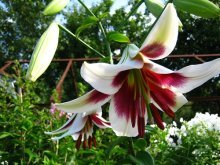


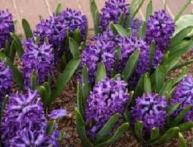
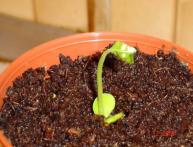
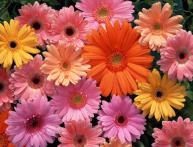
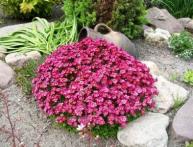
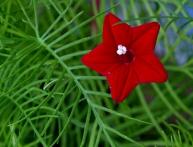
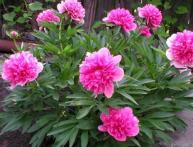

Comments
My favorite flower! Thanks for the article, now I understand what I did wrong when growing